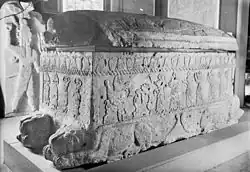Memory of the World Register – Arab States

UNESCO's Memory of the World International Register lists documentary heritage – texts, audio-visual materials, library and archive holdings[1] – that have been judged to be of global importance. The register brings that heritage to the attention of experts and the wider public, promoting the preservation, digitization, and dissemination of those materials.[2]
The first inscriptions were added to the register in 1997.[3][4] As of 2023, 496 pieces of documentary heritage had been included in the register.[5] Of these, seventeen were nominated by countries from the region of the Arab States. They include religious and secular manuscripts, texts carved on stone, maps, and historical archives.
Image gallery
-
.jpg) Rock inscriptions at Jabal Ikmah, Saudi Arabia
Rock inscriptions at Jabal Ikmah, Saudi Arabia -
.jpg) Frontispiece from a Mamluk Quran manuscript, Egyptian National Library
Frontispiece from a Mamluk Quran manuscript, Egyptian National Library -
 Commemorative stela of Nahr el-Kalb, Lebanon
Commemorative stela of Nahr el-Kalb, Lebanon -
 The Beggar at the Mosque from the Persian Illustrated and Illuminated Manuscripts of the Egyptian National Library
The Beggar at the Mosque from the Persian Illustrated and Illuminated Manuscripts of the Egyptian National Library
List by country/territory
Notes
^ Names and spellings provided are based on the official list released by the Memory of the World Programme.
References
- ^ Diop, Papa Momar; Jordan, Lothar (2022). "The UNESCO Memory of the World Program as a Possible Catalyst for Fostering Peace and Peace Studies in Africa". Peace Studies for Sustainable Development in Africa. Advances in African Economic, Social and Political Development. pp. 763–773. doi:10.1007/978-3-030-92474-4_56. ISBN 978-3-030-92473-7.
- ^ "64 new inscriptions on UNESCO's Memory of the World Registers". UNESCO Press. 24 May 2023. Retrieved 2024-12-18.
- ^ Edmondson, Ray (2020). "Memory of the World: An Introduction". In Edmondson, Ray; Jordan, Lothar; Prodan, Anca Claudia (eds.). The UNESCO Memory of the World Programme: Key Aspects and Recent Developments. Cham: Springer. pp. 21–22. ISBN 978-3-030-18441-4.
- ^ "Launch of the International Memory of the World Register 2022-2023 Cycle". UNESCO Memory of the World Programme. 1 July 2021. Retrieved 2024-12-18.
- ^ "Documentary heritage: 74 new entries on UNESCO's Memory of the World Register". UNESCO Memory of the World Programme. 17 April 2025. Archived from the original on 2025-05-28. Retrieved 2025-07-15.
- ^ "Al – Mustamlah Min Kitab Al – Takmila". UNESCO Memory of the World. Retrieved 2025-02-14.
- ^ "First Summit Meeting of the Non-Aligned Movement Archives". UNESCO Memory of the World. Retrieved 2025-02-18.
- ^ "Memory of the Suez Canal". UNESCO Memory of the World Programme. Retrieved 2025-02-18.
- ^ "The National Library of Egypt's Collection of Mamluk Qur'an Manuscripts". UNESCO Memory of the World Programme. Retrieved 2025-02-14.
- ^ "Deeds of Sultans and Princes". UNESCO Memory of the World Programme. Retrieved 2025-02-14.
- ^ "Persian Illustrated and Illuminated Manuscripts". UNESCO Memory of the World Programme. Retrieved 2025-02-14.
- ^ "The Phoenician Alphabet". UNESCO Memory of the World Programme. Retrieved 2025-02-14.
- ^ "Commemorative stela of Nahr el-Kalb, Mount Lebanon". UNESCO Memory of the World Programme. Retrieved 2025-02-14.
- ^ "Kitab al-ibar, wa diwan al-mobtadae wa al-khabar". UNESCO Memory of the World Programme. Retrieved 2025-02-14.
- ^ "Manuscript of al- Zahrāwīsu". UNESCO Memory of the World Programme. Retrieved 2025-02-14.
- ^ "Maden Al Asrar Fi Elm Al Behar Manuscript". UNESCO Memory of the World Programme. Retrieved 2025-02-14.
- ^ "Earliest Islamic (Kufic) inscription". UNESCO Memory of the World Programme. Retrieved 2025-02-14.
- ^ "Arabian Chronicles in Stone: Jabal Ikmah". UNESCO Memory of the World Programme. Retrieved 2025-02-14.
- ^ "Privateering and the international relations of the Regency of Tunis in the 18th and 19th centuries". UNESCO Memory of the World Programme. Retrieved 2025-02-14.
- ^ "The Abolition of Slavery in Tunisia 1841-1846". UNESCO Memory of the World Programme. Retrieved 2025-02-14.
- ^ "The Music holdings in Baron Rodolphe d'Erlanger's archives (1910-1932)". UNESCO Memory of the World Programme. Retrieved 2025-02-14.